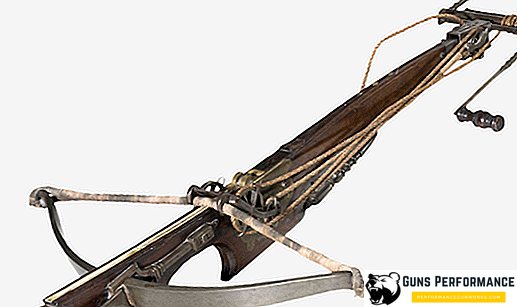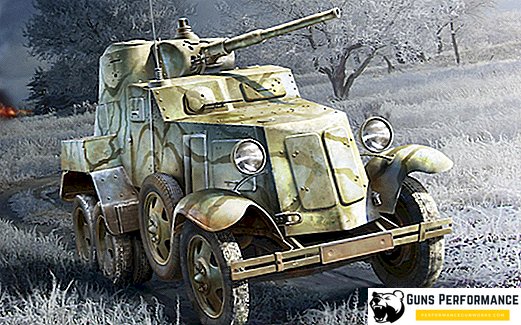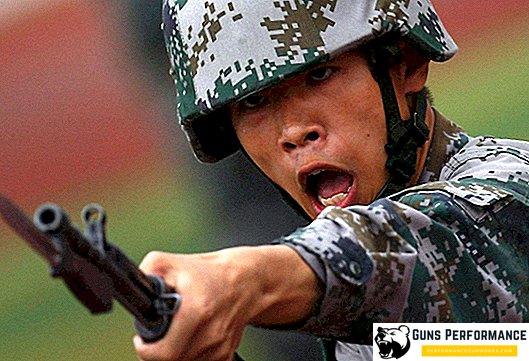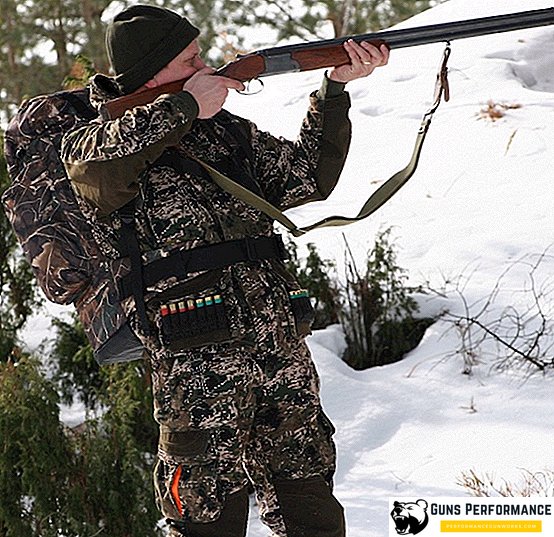"How do you think, why noble knights hate a crossbow so much? I would say - in this hatred something personal is seen, no? ..." - "Well, they heard: remote weapons are cowards' weapons." “Oh, no, it's harder. Take note of the bows! Nobody really objects. The trick is that the best bow has a hundred pounds of force on the bow and the crossbow has a thousand.” - "Well, so what?" - "And the fact that an archer can knock down a clergyman, only having gotten into the slot, he took high-quality art into the soldering of the shell and tede, you need to learn from the age of three, then you will be able to do something by the age of twenty. The crossbowman shoots on the contour - wherever you get, everything is right through: a month of preparation - and a fifteen-year-old apprentice, who never held a weapon in his hands, would wipe his sleeve with a snot, follow with hundreds of yards, and cover the famous Baron N, the winner of forty-two tournaments, and so on, and so on ... "
K. Eskov "Last Koltsenosets"

In childhood, many of us enthusiastically read out books that told about the adventures of the noble robber Robin Hood, who at one time brought a lot of "rustle" in the forests of good old England. The legendary hero masterly owned one of the most deadly types of medieval throwing weapons - a large English bow. Everybody knows about it. Much less well-known and popular is the main competitor of the bow on the battlefield - the fighting crossbow. And it is absolutely in vain, for the crossbowmen were rightfully considered the elite of the medieval infantry.
A crossbow is a type of throwing weapon consisting of a bow placed on a special bed, and mechanisms for cocking and lowering the bowstring. It greatly exceeds the usual bow in range and destructive power, but inferior to him in rate of fire. The French name of the weapon "crossbow" comes from two Latin words: arcus, which means "arc", and the ballisto - "throw or throw." Arrows for a crossbow are called bolts, some types of crossbows, could shoot special bullets. A simple crossbow can be called the most technological hand weapon of Antiquity and the Middle Ages.

Why do we need a crossbow if there is a simpler and quick-fire bow, known to man since the Stone Age? The bowman must hold the string in the tensioned state during aiming, which reduces the accuracy of shooting and significantly increases the training requirements for the shooter. The mechanism of the crossbow allows you to hold the tensioned string and at the same time to aim. Therefore, to shoot from a crossbow, it was possible to train almost anyone, even the slightest trained peasant could sow a knight's horse, chained in expensive armor.
In recent decades, interest in this weapon has been reviving. A modern crossbow as a whole repeats the design of its medieval predecessor, but in its manufacture completely different technologies and materials are used. Today the most popular crossbows for hunting and sports models of this weapon. It is easy to make this weapon with your own hands by downloading a crossbow drawing on the Internet.

Before turning to the description of modern types of these weapons, one should give a general overview of crossbows, say a few words about their history, and also tell in more detail about the device of the crossbow.
Description of construction
The classic medieval crossbow consisted of a box, inside which was a trigger mechanism. A bow was fastened to the front of the bed, which could consist of wood, steel or horn, as well as a stirrup to tighten the bowstring. On the upper surface of the bed was made a special groove for bolts.

The trigger for the crossbow could have a different design, but most often this node consisted of a special washer ("nut"), trigger lever and spring. The Nut had a slot for the tail of the bolt, a special hook for a crossbow string, and a retaining spring. After pressing the trigger lever washers released from fixation and under the action of the string rotated around its axis, freeing it from the hook. So was the crossbow shot.
It seems that for centuries, manufacturers of crossbows did not care about the ergonomics of their products. What can be more convenient and natural than pressing the trigger lever with a single index finger, as is done when using modern small arms? But for the ancient masters it was not at all obvious. The crossbow's release lever was released with the whole brush, while doing a back-up movement. No less strange is the absolute absence of the butt with shoulder support on early models of crossbows. But the most powerful models of manual crossbows had a tension force of 600 kg and a corresponding fierce return. Butts at crossbows appeared already at the end of their evolution, under the influence of muskets and shotguns. Interestingly, but before that, the crossbowmen anatomy was different?
The bows of the bow could be completely wooden or consist of different components or be made of elastic steel. Another term is associated with the shape of arcs - “recursive crossbow”. This is a weapon that has a characteristic bow bow. This design increases the efficiency of the power of the weapon, creating an additional lever. Recursive crossbow is often used today for hunting and sport shooting.

Steel arches provided the weapon with maximum power, but the most common was still a composite bow, which had a very complex composition and various modifications.
For the manufacture of composite onions used wood of different breeds, tendons and horns of animals. All of this stuck together among themselves, and each master had his own glue composition. There were crossbows for every taste and wealth, in more expensive models, the arches were reinforced with whalebrow plates and wrapped in calfskin. By the way, to get a kilogram of tendons, it was necessary to score a whole herd of cows - at least twenty heads. It is clear that the entire kilogram of raw materials was not spent on making one crossbow, but this fact gives an idea of how expensive this weapon was.
A crossbow is much more powerful than a bow, so this weapon must have a matching bowstring. It was made of linen or hemp thread, sometimes used rawhide or horsehair. To make one string, you had to connect 150 meters of high quality hemp thread. It should not have nodules or nodules. Weaving a string on a special machine, this process required a very high qualification from the master.

Bowstring crossbow (like a bow) was afraid of high humidity. However, if the bow was usually removed from a bow after shooting, the crossbow always remained in a tense state. Therefore, to protect their weapons from the weather, the crossbowmen put special covers on them.

European medieval bolts for crossbows usually had a length of 30-40 cm, and their weight could reach 160 or 200 grams, some bolts had a mass of up to 800 grams, but such giants usually fired from stationary crossbows. In general, these munitions clearly wore an "armor-piercing" character. Sometimes they did without tail, but usually it was still present and consisted of two or three stabilizers made from flight feathers of birds, pieces of leather, or the thinnest wooden slats.

The shape of the tip of the bolt could be different. There were two ways to attach the crossbow's arrowhead. The vtula tip was simply put on the arrow, and then additionally fixed with one or two nails, and the petiolate ended in a long needle that drove into the shaft to the stop. To keep the pole from bursting, it was tightly wrapped on top of it.
Crossbows for hunting used lighter ammunition.
Medieval masters did not know the laws of aerodynamics, so the shape of crossbow arrows was perfected for centuries by trial and error. In the design of the bolts, they managed to achieve perfection. This was shown by wind tunnel tests conducted several years ago at Pardue University. Moreover, in terms of its “flight” characteristics, the arbalest bolt significantly exceeded the usual arrow for a bow.

Early crossbows of the period of Antiquity and the early Middle Ages were cocked manually or using a special belt hook. The warrior put his foot in the stirrup, bent down, hooked the hook with the hook and straightened the torso. At the same time, the load was distributed between the strongest muscles of the human body: the extensors of the back, abdominal pressure and the broadest muscle. If the string was simply held by hand, it was usually made wider. Later, an improvement was made to the belt of the crossbowman - a special block device with one or two rollers. This was called the "Samson Belt", with its help it was possible to crossbows with a tension force of up to 180 kg.

However, this was not enough soon. In order to charge an even more powerful weapon, a special lever system was invented, called the goat's foot. This type of cocking was very popular throughout the Middle Ages, as it was distinguished by simplicity and provided a very high rate of fire weapons. However, the wide distribution of plate armor required the creation of an even more powerful crossbow, for which the "goat-foot" was not enough to load. As a result, block devices for crossbow tension appeared. There were several types of them.

The English gate was a winch, which was fixed in the back of the bed. This crossbow mechanism tightened the bowstring and brought the weapon into position. As a rule, the English gate was removable. This device was simple and reliable, but the rate of crossbows with a similar mechanism was not too high.

Another system for charging powerful crossbows was the so-called German gate or crankelin, which was a fairly perfect gear-and-gear mechanism. It consisted of two gears, a handle and a gear rack. To cock the gun, the fighter clung to the string with a rail and began to twist the handle. This crossbow mechanism, as a rule, was also removable. Krankelin was a reliable and very effective device, with its help it was possible to cock the most powerful crossbow. True, he weighed a lot and was difficult to manufacture, so he was expensive.

It should be noted that all of the above types of crossbows were used at the same time.
Crossbow history
Today it is not known for certain who and where the idea of creating a crossbow first came to mind. In this regard, historians have several theories. According to one of them, the crossbow was invented in China, as far back as the V century BC. Although, most likely, it was not familiar to us hand-made light crossbow, it was of considerable size and was used during the siege of cities and fortresses. Later in China, a multi-shot crossbow was invented; however, it is not known how effective it was in practice.
Regardless of the Chinese, the ancient Greeks came up with the design of the crossbow: their manual crossbow was called a gastrophete or abdominal bow. Known were the Hellenes and heavy ballista who worked on a similar principle. True, it is still not clear how the string string of the gastrofet was stretched: either simply with your hands, or with the help of a cunning lever, which was piled on with a stomach. Historians have no consensus on this.

The Romans for some reason practically did not use the crossbow, although they knew it very well.
In general, it should be said that some of its features prevented the wide distribution of these weapons. First, a crossbow is a typical infantry weapon that is difficult for a rider to use. Therefore, peoples who preferred to fight on horseback (the Mongols, Persians, Arabs) used a complex composite bow — a formidable weapon in the hands of an experienced warrior. Secondly, it is difficult for a crossbowman to participate in a hand-to-hand fight - his own weapon prevents him. Crossbowmen in battle should be covered, which requires a rather high tactical training of the troops and its good organization. Perhaps that is why in the era of the early Middle Ages, crossbows are not too popular.

In 1139, at the second Lateran Council, which was convened by Pope Innocent II, crossbows were banned as a weapon hated by the Lord. The churchmen stated that it was inappropriate for a decent Christian to use a crossbow, since the wounds inflicted on him were terrible. It could only be used against the Turks, well, or other infidels. The next pope, Innocent III, left the decision of the council in force. It must be said that the military of that time paid little attention to such "humanistic" initiatives of the church, roughly speaking, crossbows continued to be used, because their effectiveness was high. Legendary English king Richard the Lionheart became a victim of this weapon. In 1199, he died from a wound inflicted on him by a crossbow bolt.
The first mention of European crossbows refer to the period of the Crusades. This weapon began to gain wide popularity at the turn of the XI-XII centuries, at the same time loading with a belt hook came into use, the first crossbows with a collar appeared.

Already in the XIII century, almost no serious campaign could not do without the participation of crossbowmen. The most famous were the Genoese crossbowmen - foot soldiers, who as mercenaries for several centuries participated in European wars. They gained the greatest fame in the fields of the Hundred Years War.
In Russia, the crossbow was also known, but it was not widely spread. In places of past battles, excavated by domestic archaeologists, there are usually about twenty arrowheads for one tip of a crossbow bolt.

The active use of the crossbow in Europe ended with the improvement of firearms, which could almost completely replace it in about the XVI century. The last time a crossbow was used in combat at the end of the 17th century was during the Danish-Swedish wars. But the Danes did not use this weapon from a good life, but because they simply did not have enough guns.
Application and fighting qualities of the crossbow
As mentioned above, the main advantage of a crossbow over a regular bow was the ability to keep the bowstring taut when aiming. Do you think this is nothing?

The tension force of modern sports bows rarely exceeds 40 kg (usually 20-25 kg for men), and for a shot from their medieval combat counterparts, an effort of 80 kg was needed. These are specifically “weight-lifting” loads that absolutely exclude “sporting” aiming: with an unhurried selection of a target, long holding the bow in a stretched state, slowly pulling the string to the corner of the eye or ear. All this was done a little differently: the bow was straightened with both hands at once, jerking in opposite directions ("to break") and the shot was fired instantly. In this case, the archer’s rate of fire could reach 19 rounds per minute, 13 rounds was considered the norm. And how to aim, you ask?
Ask the Olympic champion about this, which shows results that are completely unthinkable for most ordinary people. He will simply answer you that the first time his father brought him to the gym at five or six years old. At about the same age, the tatarchon received his first bow, and by the age of sixteen, the question of how to aim was no longer there. Moreover, it was not even a matter of special training, it was just as natural to shoot a bow for representatives of great traditions - English, Scythian or Mongolian - as for Brazilians to play football from childhood. The moral of this retreat is very simple: a good archer is a "piece" product, which takes years to prepare.
Any good shot from a combat bow is the result of three components: the strength of the archer, the speed of his movements and accuracy. Therefore, it seems amusing that modern authors of historical and fantasy works often give combat bows to girls or teenagers, sending men with bladed weapons to the front line. This is from poor knowledge of the subject. Shooting from a war bow is clearly not a female occupation that requires the highest strength training.
Prepare the crossbowman much easier and faster. Recruit was enough to explain the scheme of loading and show how the trigger for the crossbow. A little workout and you could put it on the wall. So, by the way, it often happened: as a rule, crossbows were kept in urban arsenals, and when the enemy approached the walls they were handed out to the militia.
The crossbow has other advantages. He was much stronger than the bow, but since his bowstring was pulled with a lever or gate, this weapon saved the shooter's physical efforts.

How strong were the crossbows? It can be said that the usual block crossbow (with cranquelin) had a tension force of 250-300 kg, but there were also giants, whose figure reached 400 kg and even 600 kg. Правда, из таких арбалетов, вероятно, нужно было стрелять с опоры. Даже легкие арбалеты могли похвастать энергией выстрела в 150 Дж, что в разы больше, чем у большинства луков. Тяжелые образцы этого оружия имели энергию в 400 Дж, что превосходит аналогичный показатель пистолета Макарова (340 Дж).
Решающую роль в широком распространении арбалетов стало оснащение их воротным устройством. С этого момента его превосходство в пробивной способности над луком стало просто подавляющим.

Легкий арбалет стрелял на дистанцию в 250 метров и мог пробить кольчугу на расстоянии 80 метров. Вблизи он был способен поразить воина в тяжелых доспехах. Характеристики тяжелого арбалета еще более впечатляющи. Стрелял он на 400-450 метров, на дистанции в 250 метров пробивал кольчугу, а стальную кирасу с кольчугой и ватником - на расстоянии 25 метров.
Арбалет очень долго был самым точным оружием, которое могло поразить противника на расстоянии. Сравняться по этой характеристике с ним смогло только нарезное огнестрельное оружие, появившееся где-то в XVIII веке. Хорошо подготовленный лучник также был довольно меток, но только пока он использовал стрелы, изготовленные им лично. Боеприпасы из обоза снижали точность лука в разы. Арбалетные болты в этом отношении были более унифицированы.
Любопытно, но изготовление арбалетных болтов можно назвать первым по-настоящему массовым промышленным производством, которое было развернуто задолго до промышленной революции. В арсеналах крепостей и городов хранились десятки тысяч болтов, занимались их изготовлением обычно специальные группы ремесленников или семьи. Для производства использовалось довольно сложное оборудование. Одна английская семья, которая специализировалась на выпуске арбалетных болтов, за несколько поколений (70 лет) сумела изготовить около миллиона единиц подобной продукции.

Главным недостатком арбалета по сравнению с луком была его малая скорострельность. Если говорить об оружии, которое взводилось при помощи воротов, то оно могло делать два-три выстрела в минуту. Во время перезарядки оружия арбалетчики нередко прикрывались специальными тяжелыми щитами - "павезами".
Еще одним минусом арбалетов была их высокая стоимость. Позволить себе такое оружие мог далеко не каждый.
Если европейские арбалеты носили явно "бронебойный" характер, то китайцы, которые также любили это оружие, использовали другую тактику. Их арбалеты были рассчитаны на максимальную дальность выстрела, поэтому имели легкие стрелы, очень похожие на лучные.

Европейцы часто применяли арбалеты при обороне крепостей. Одной из самых "приоритетных" целей для особо мощных экземпляров этого оружия была орудийная прислуга, стреляющая по городским стенам. Нередко использовали арбалеты и в морских сражениях.
По поводу бронебойности арбалета можно сказать одно, рыцарь в полных доспехах XV столетия был практически неуязвимой целью даже для мощных пехотных арбалетов.
Если говорить о боестолкновении двух армий в открытом поле, то здесь, конечно же, арбалет проигрывал луку. С тактической точки зрения, арбалет - это оружие для прицельной настильной стрельбы. Навесом из него можно стрелять, но на максимальной дальности вероятность поражения противника крайне низка. Невысокая скорострельность и сравнительно редкое размещение арбалетчиков по фронту не дает достичь такой плотности огня, чтобы предотвратить сближение с противником на дистанцию рукопашного боя, и гарантировано подавить его. Именно поэтому арбалетчики не были способны сыграть в полевом бою той решающей роли, которую нередко выполняли лучники.

Среди любителей военной истории часто возникают споры, что лучше арбалет или лук? Этот вопрос не слишком корректен. Во время широкого использования этих видов метательного оружия они, как правило, не конкурировали, а дополняли друг друга на поле боя. Лук хорошо подходил конным воинам, а арбалет - пехотинцам, особенно в обороне крепостей, в морских сражениях и других подобных операциях.
Современные арбалеты
В последние десятилетия наблюдается возрождение интереса к арбалету. С середины 50-х годов в Европе и США начал развиваться арбалетный спорт. Позже это оружие начали использовать и для охоты. Считается, что она более гуманна, так как дает животному больше шансов на выживание.
Естественно, что никто не делает современный арбалет из дерева. Новые арбалеты имеют конструкцию, в которой активно используются самые "продвинутые" материалы - алюминий, титан, углепластики. Охотничий арбалет нередко оснащается оптическим или коллиматорным прицелом, лазерным целеуказателем, его стоимость может достигать нескольких тысяч долларов.

В состав конструкции многих современных арбалетов входят специальные ролики-блоки, которые снижают усилия для натяжения тетивы и увеличивают скорострельность. Кроме того, блочный арбалет, как правило, имеет меньшие габариты. Существуют и так называемые обратные арбалеты, у которых плечи лука направлены в противоположную (по сравнению с классическим оружием) сторону. Такую конструкцию предложил еще гениальный Леонардо да Винчи, но серийно изготавливать подобные арбалеты начали только недавно.
В интернете можно даже найти арбалет для подводной охоты, хотя, это оружие к классическому арбалету имеет весьма отдаленное отношение.

Нашлось применение арбалету и в армии: этот тип метательного оружия используется некоторыми специальными подразделениями. Обычно это небольшие пистолетные арбалеты, их применяют, когда нужно нейтрализовать противника без лишнего шума. Первый мини-арбалет для диверсионных целей был создан в США еще в 60-е годы прошлого века. Он находился на вооружении более пятнадцати лет.
Хотя, надо сказать, что широкого распространения в современной армии арбалеты не получили. Бесшумное огнестрельное оружие превосходит их по всем параметрам.












